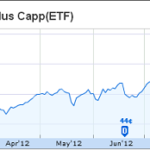Investors have routinely watched the volatility indicators like the VIX to measure investor “fear” in the market via the implied volatility of the underlying index options. In recent years, they’ve been able to partake in spikes in volatility as a portfolio hedge via the exchange traded notes, otherwise known as ETNs (VXX) and (VXN) which track volatility futures in the broader market and the NASDAQ. But what about when the VIX runs up in spectacular fashion and it’s evident to you at least, that there’s nowhere to go but down? In the past, you’d have to either short an existing long VIX ETF or buy puts, neither of which are appealing. Novice investors are often duped by the futures roll effect in the options, not to mention that most options expire worthless. Now though, there’s an inverse volatility ETF which allows you to buy when there’s blood in the street, if you will.
Ticker: XXV
Expense Ratio: 0.89%
Yield: n/a
ETF Basics:
Cunningly tickered the inverse of the VXX, as XXV, the ETF will basically benefit from market “calm” or seeing investors more confidently buying put options over call options. During extreme market declines, VXX and VXN have spike doubled digits in a single day and had nice monthly returns well into the 20% and 30% range. So, there’s a strong negative correlation with a boost to long market conditions.
When is XXV Useful?
With that in mind, you might be asking, why not just long the market instead of buying XXV if it’s now positively correlated with market indices? Well, the reason is that the market can somewhat meander along while volatility drops. It’s really a trading mechanism rather than a long-term hold.
Some investors like to use technical analysis and trade seemingly range-bound instruments by buying at the bottom of a range and selling at the top. By watching the VIX, some traders discern routine reoccurring patterns that tend to repeat themselves in the absence of extreme exogenous events. Of course, it’s that Black Swan that can wipe out the position, but eventually, market volatility tends to revert to the mean. We saw this following 9/11, following the financial collapse of 2008-2009 and we’ll see it during the next panic. When that happens, rather than going long shares, it may make sense to go long XXV. Now, just because it benefits from a relaxation of fear in the market, that doesn’t necessarily mean that this constitutes a legitimate safe investments like FDIC backed instruments, hybrid CDs, etc. because given an extreme scenario, volatility could remain at elevated levels for months. So, it’s not a guaranteed home run, but when investor fear seems overdone, it could certainly make for a good contrarian investment without the need for shorting ETFs which opens the door to unlimited losses.
Where’s volatility Headed from Here?
It’s tough to say, but it isn’t a stretch to assume that excluding deviations occasionally due to exogenous events, the VIX tends to revert to a relatively tight range. In the news of late, the talk has shifted from hyperinflation to deflation investing and what a European-style US Austerity initiative would do to GDP growth. Whether or not you believe him, today Barney Frank stated that while they’d target 250K earners with tax increases, there would be no VAT (Value Added Tax) implemented in the US which many were fearing. Housing and employment numbers have been mixed of late and stronger than expected earnings have buoyed the market of late, leading many to believe that while the picture may not be rosy over the next several months, a relative calm has at least set in, which would be positive for XXV.
Take Thursday’s trading session for instance. Even though the US broad market indices were all down modestly, XXV actually gained 0.35% on the day. So, it doesn’t necessarily have to be a zero-sum game between XXV and equities, just a slightly positively correlated relationship that benefits from calm investors seeing through the fog of panic and recognizing that over time, the dust always settles.
It’s important to note that ETNs are subject to the risk of the holding company, which in this case is Barclays. The solvency of Barclays/parent is not in question at this time, but anything could happen during another financial crisis. This would be something to keep in mind on top of the fact that you will have lost a bundle on XXV during a precipitous decline anyway, ironically.
Disclosure: No position in any instruments referenced in this article at time of publication.











{ 0 comments… add one now }